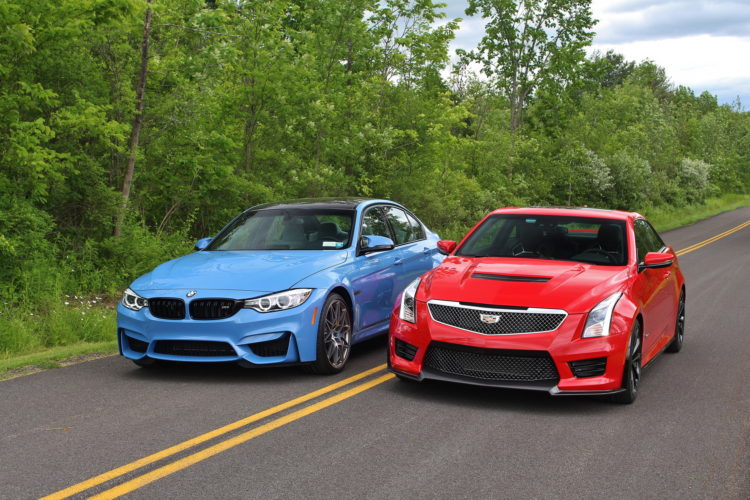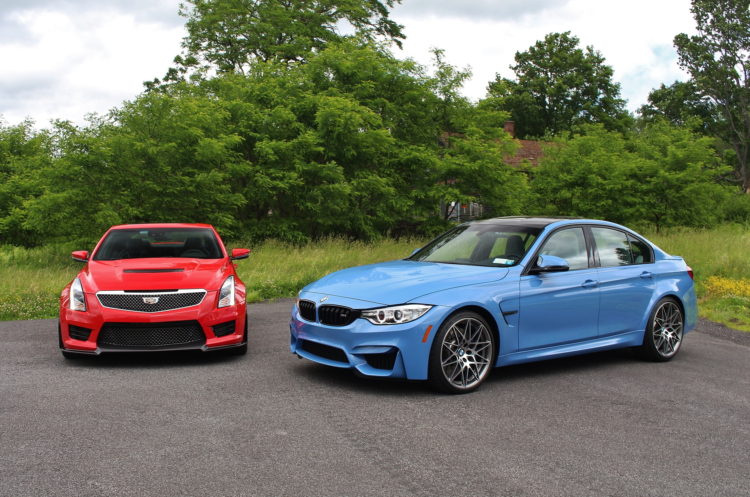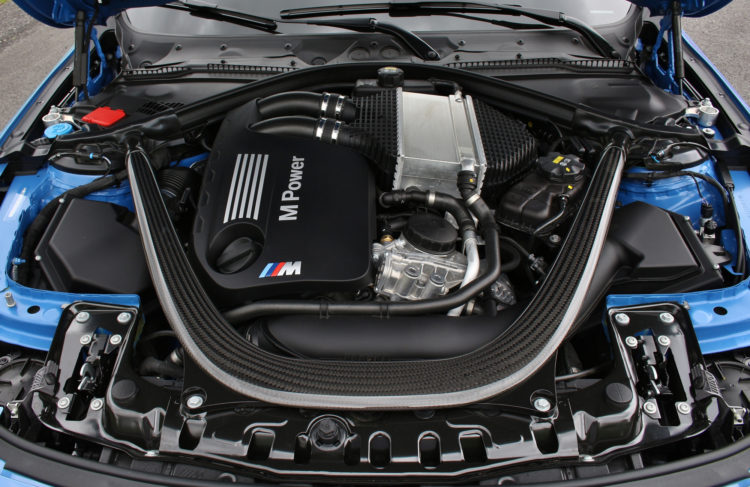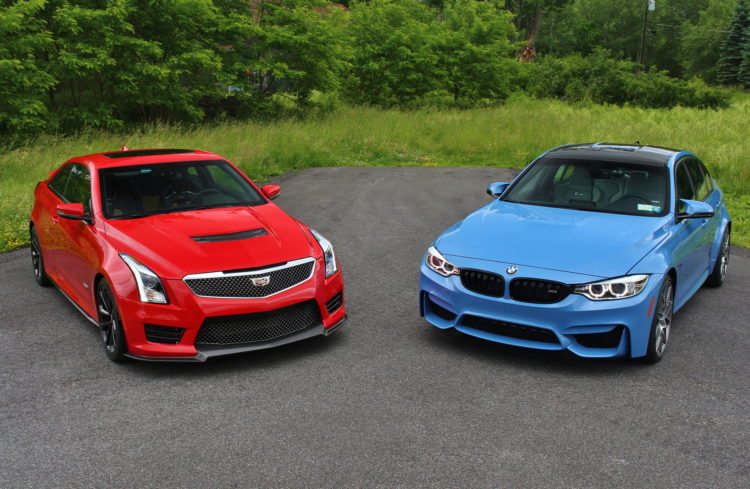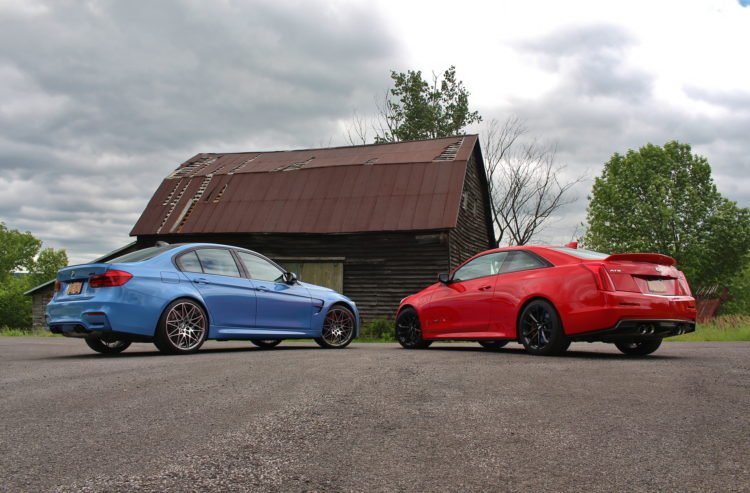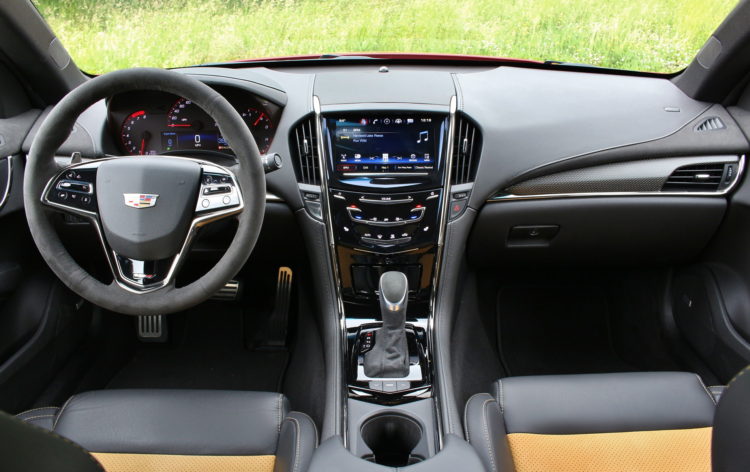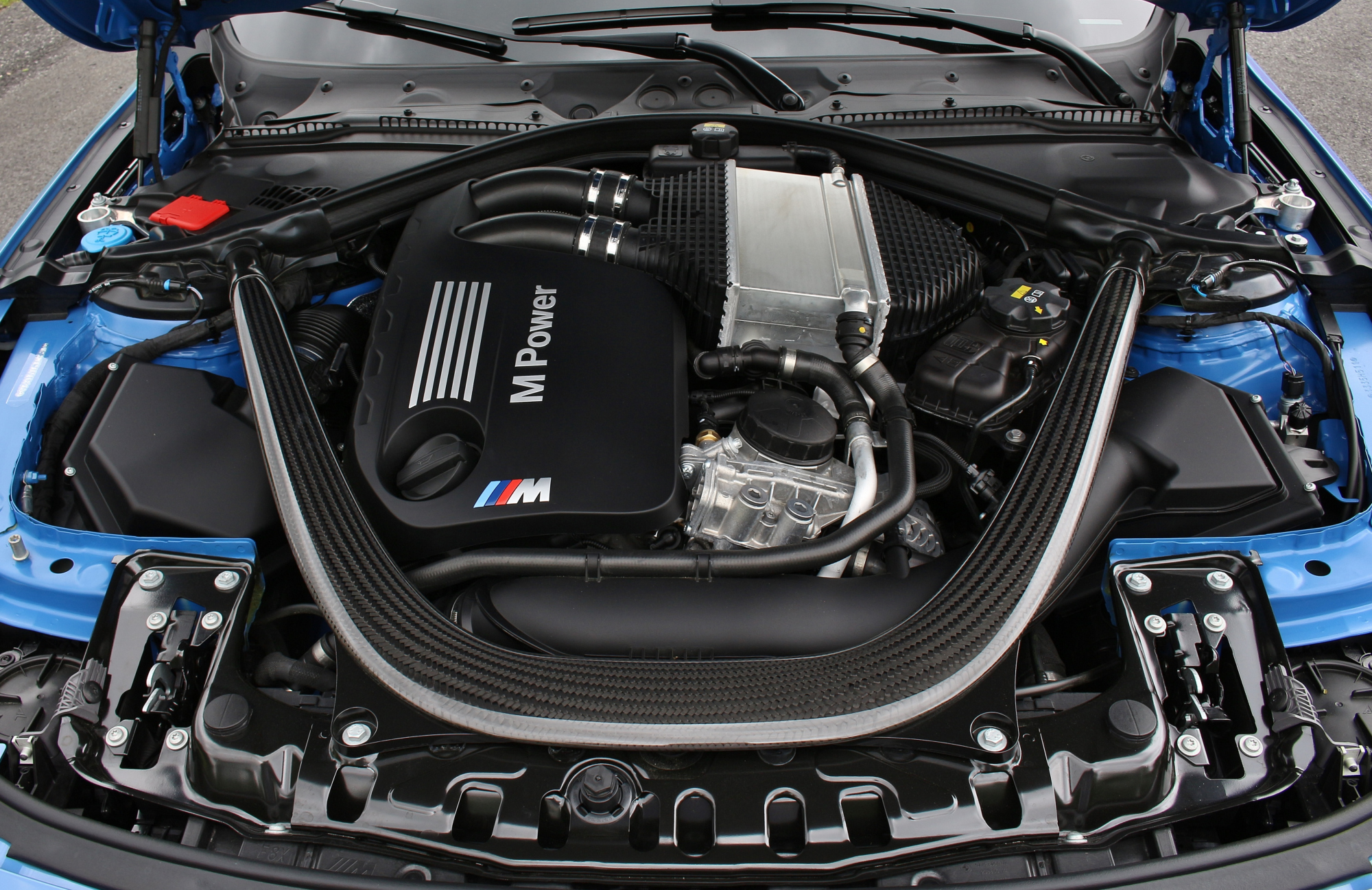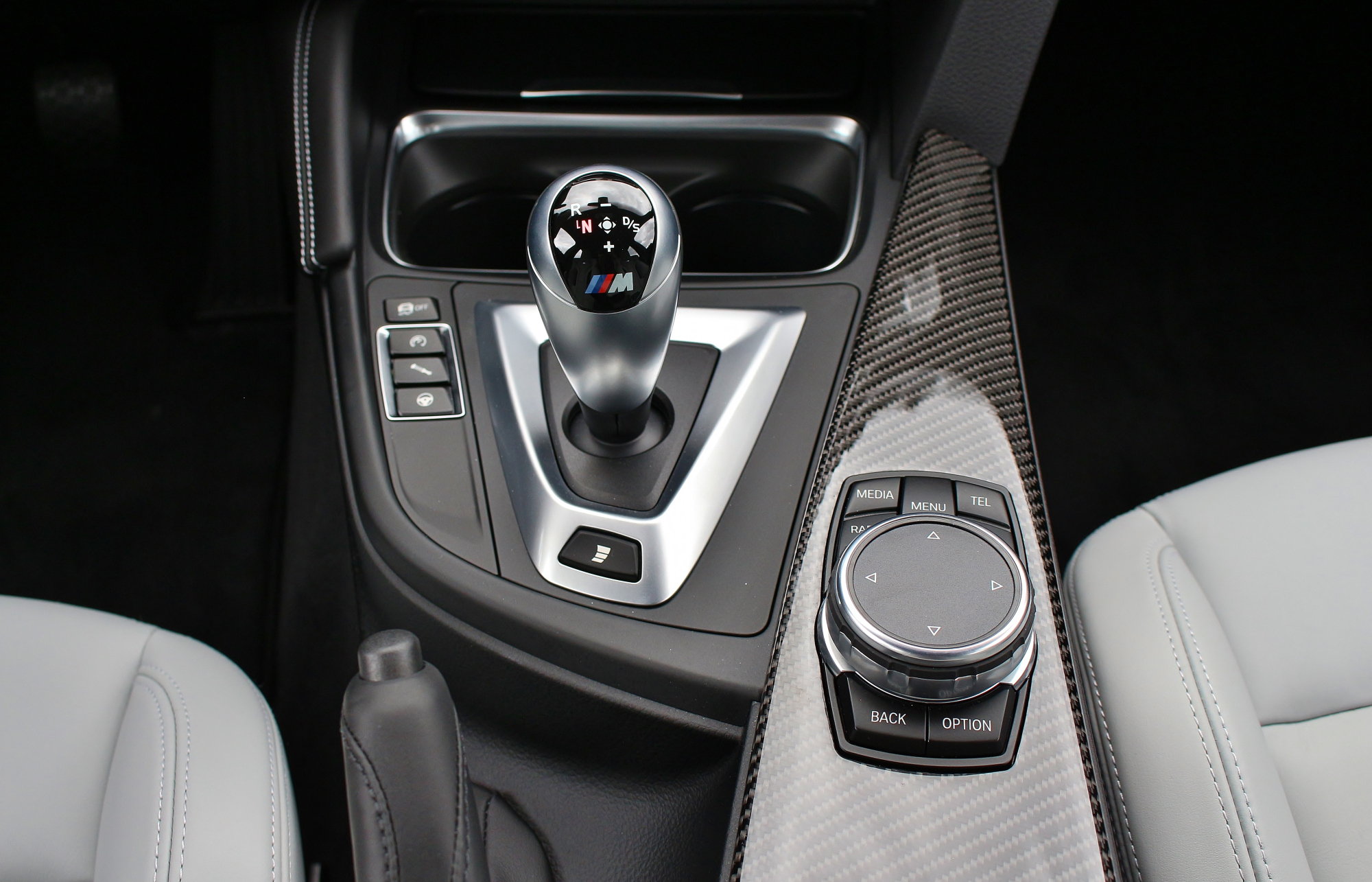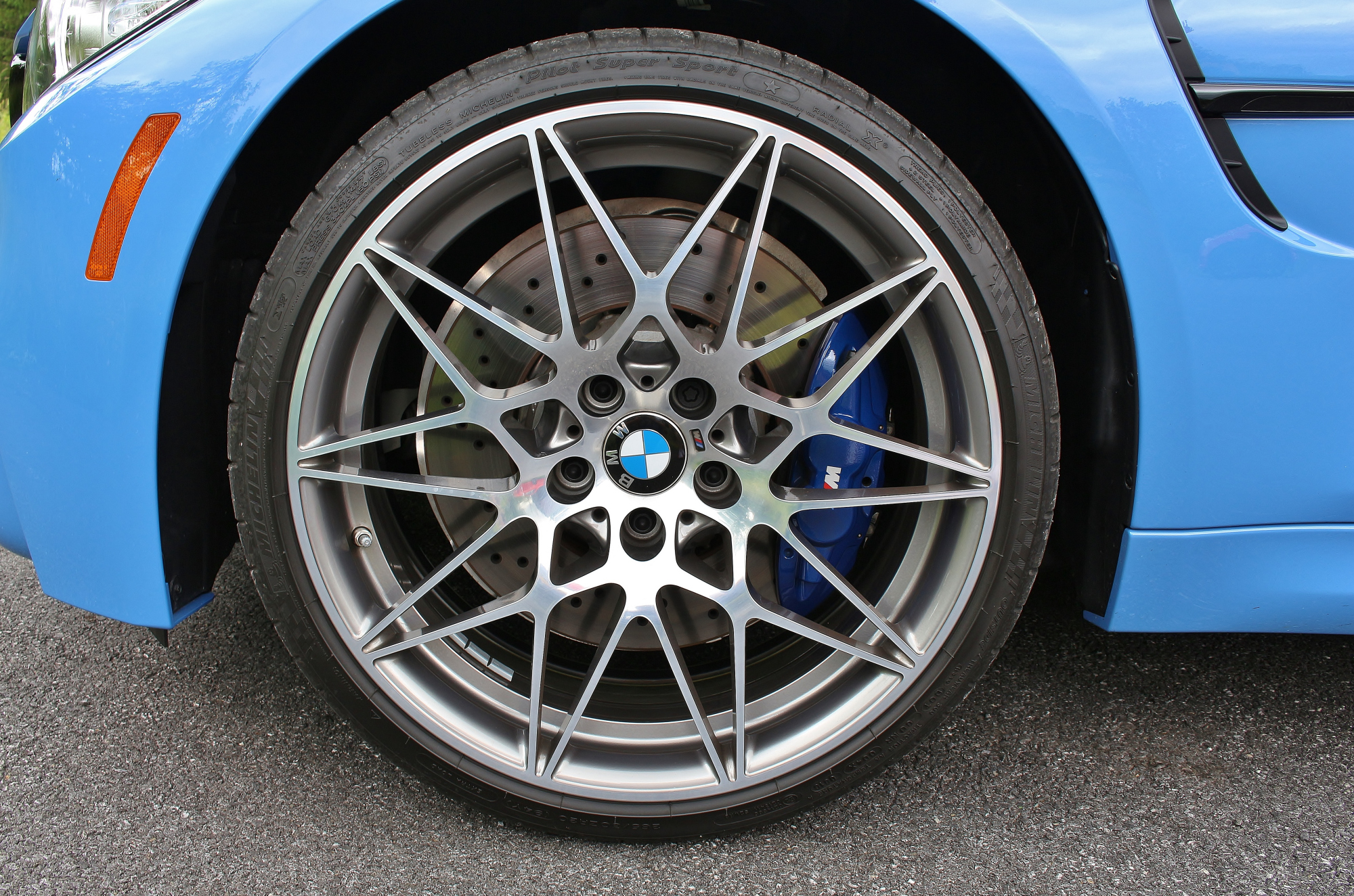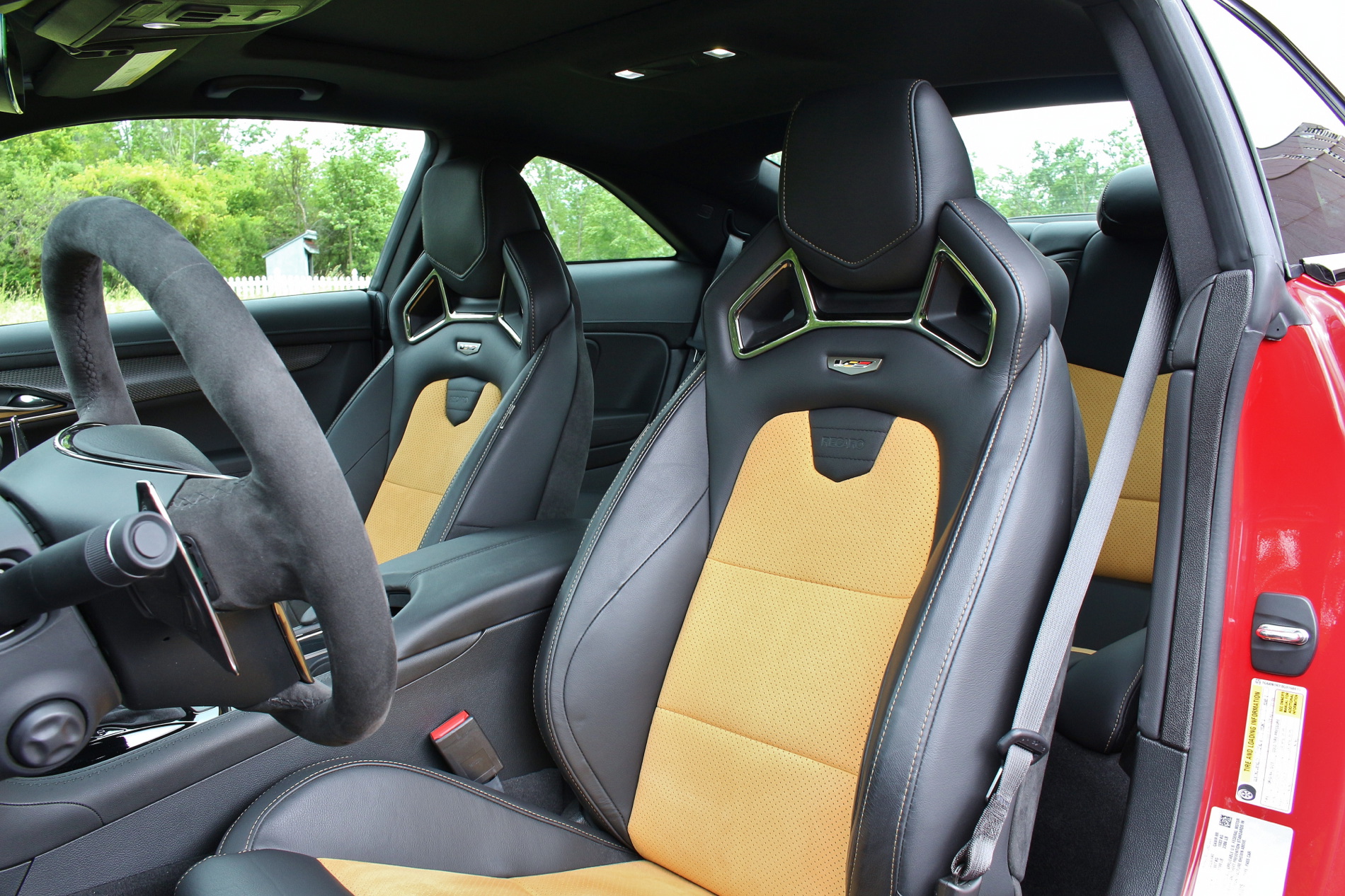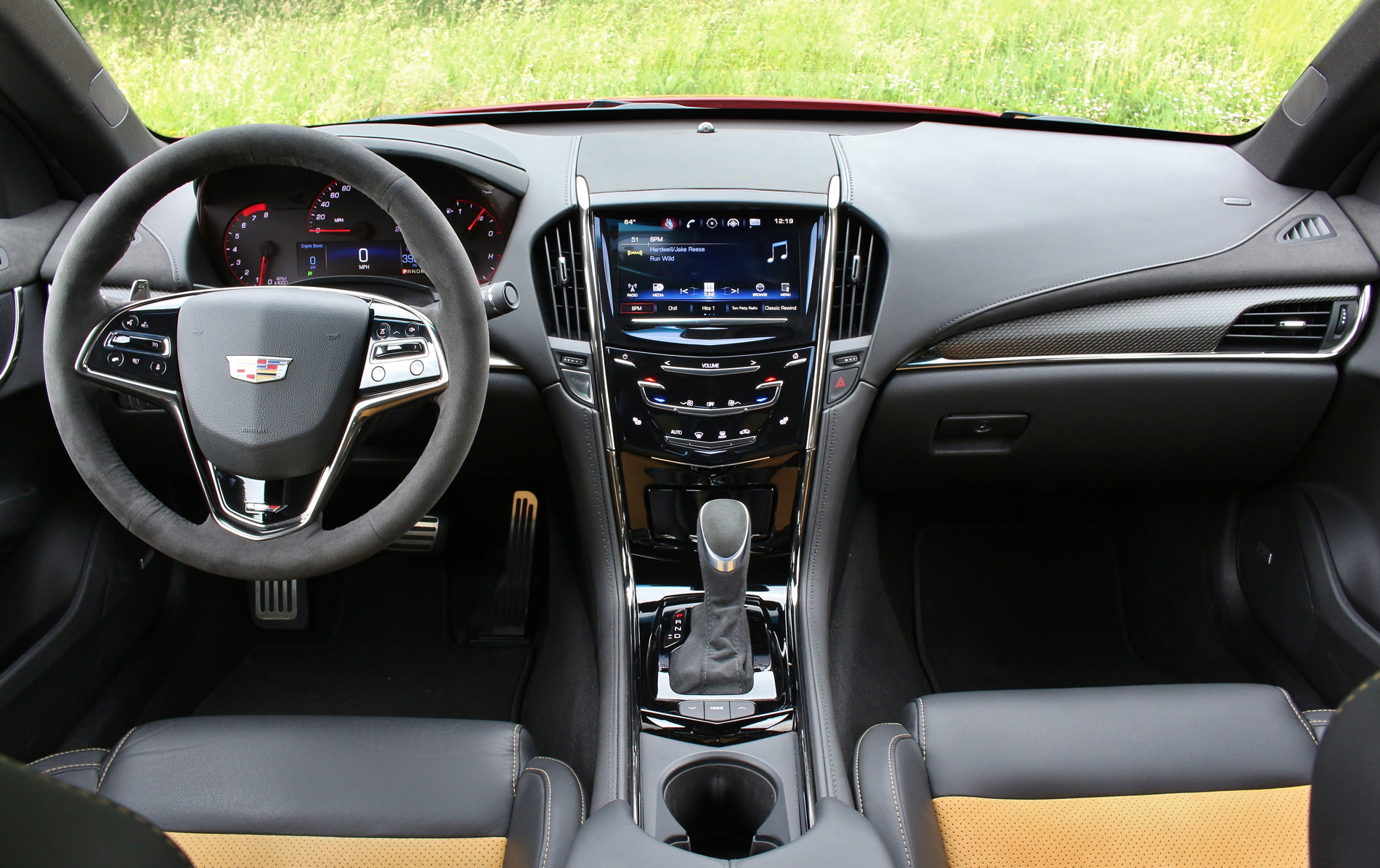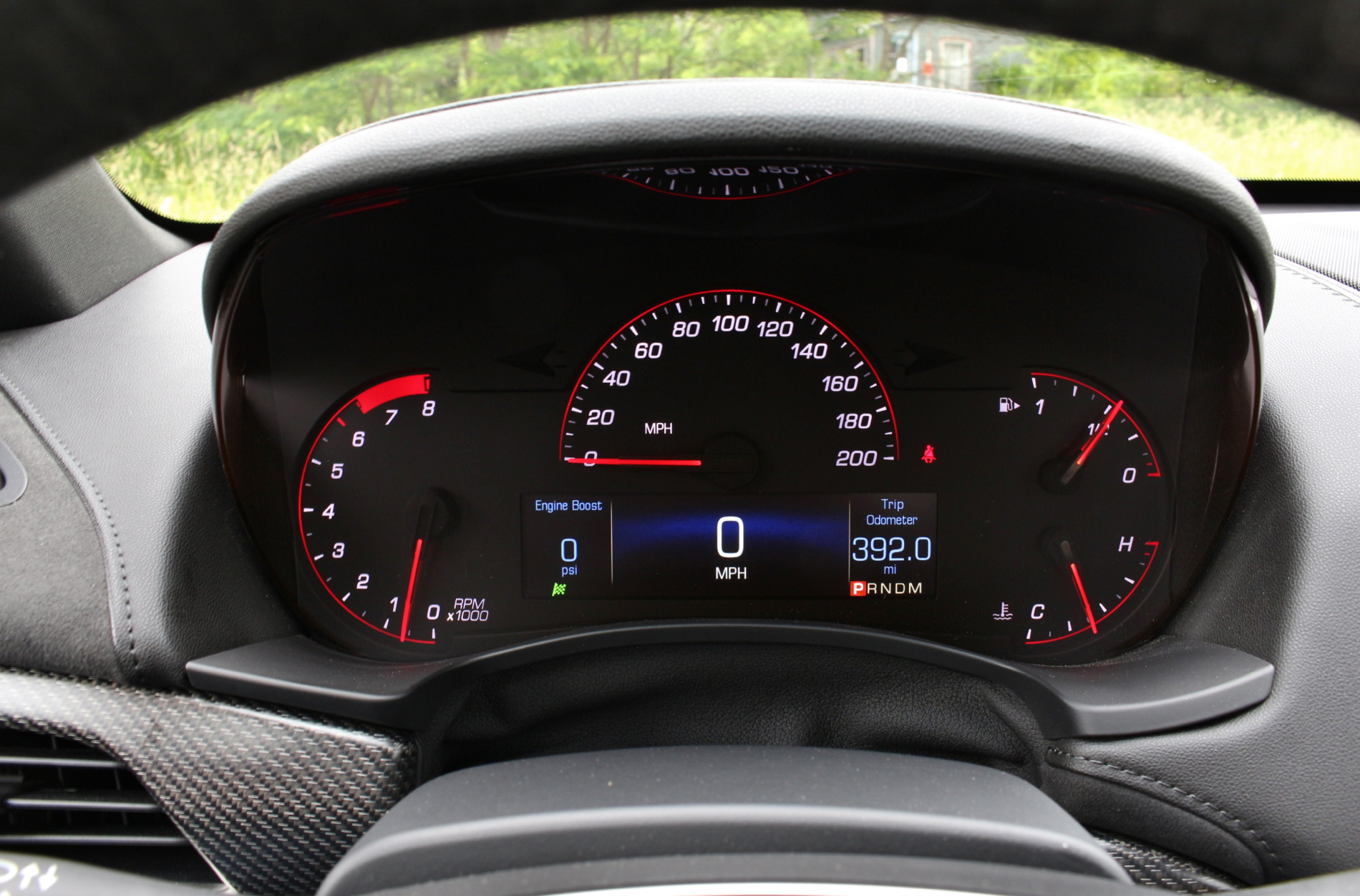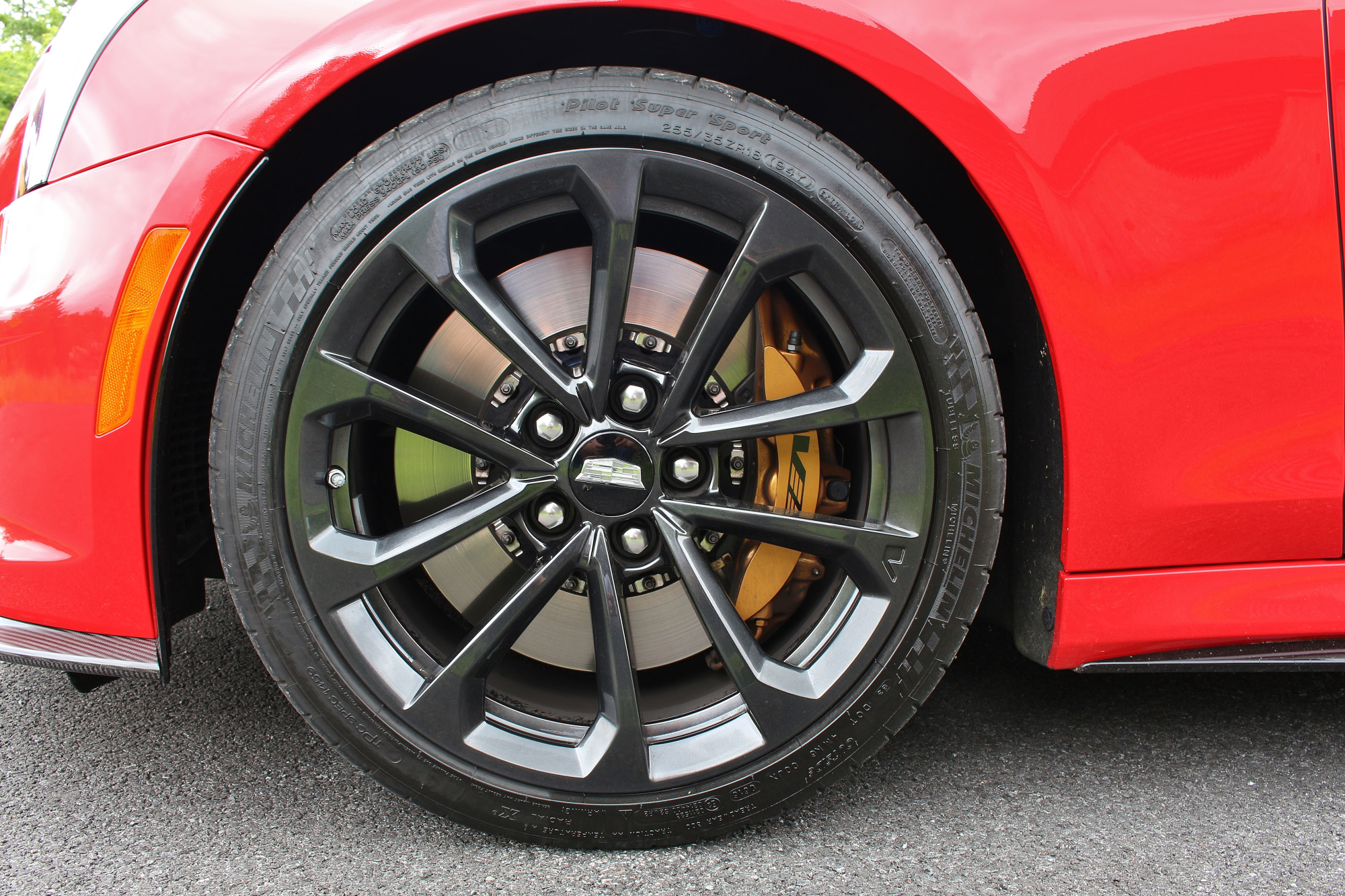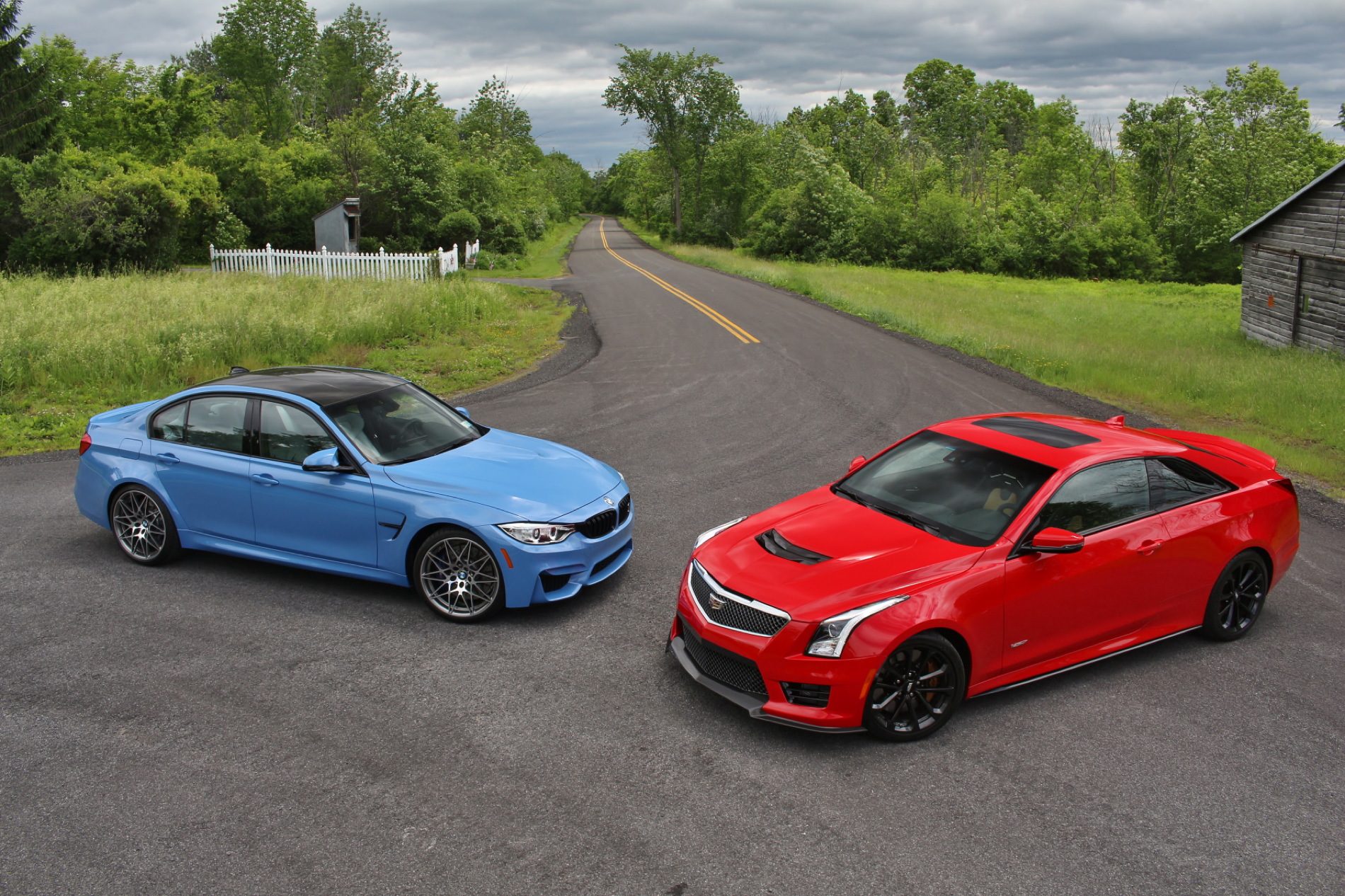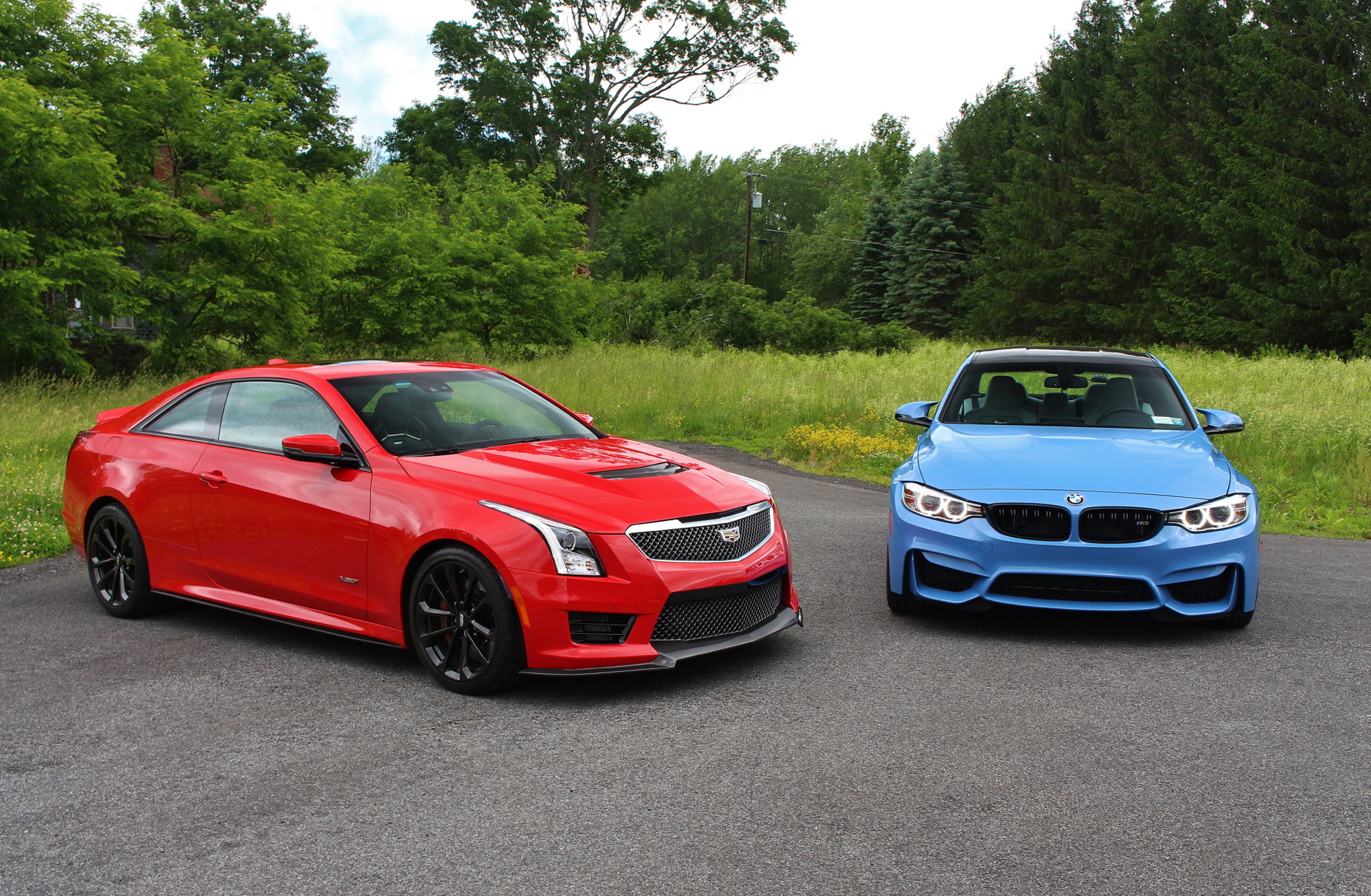For thirty years, the BMW M3 has been the go-to performance sedan. Things began to waiver in 2015 when, at the Detroit Auto Show, the fifth generation M3 was introduced. The inline six had returned after a generation of V8 experimentation, this time with two turbochargers. But it wasn’t the extra torque that dominated the discussion. Instead, BMW’s curious use of enhanced sound and electrically-assisted steering began to chip away at the M3’s granite reputation. Enter the ATS-V, Cadillac’s contender for the crown arrived just as BMW looked to be at its most vulnerable. With a twin-turbo 6 cylinder of its own and the latest iteration of General Motor’s Magnetic Ride Control, the ATS-V offers an American alternative to the German-dominated sports car market. BMW is not one to rest on its laurels. For 2016, they’ve further refined the formula with the introduction of the M3 Competition Package. Can Cadillac’s V-series bring the fight to the best from Munich’s M division?
We’re here to find out. The thing to note here is that this is not a test of track ability. They’re street cars, meant to get you to work on time, enjoy a wonderful afternoon drive on back roads, and participate in the occasional track day. As such, we kept it to the street. This is where it matters most to us. Which car would we want to spend more time in?
The Cars
When driven together, the duo caused more than one double-take. When separated, they still managed to draw plenty of attention. Taste is, of course, subjective, but these are the highlights. The ATS-V wears an all-new color, Velocity Red. It’s a color you expect to see on a Corvette, not a Cadillac.
The Cadillac also wears the $5,000 Carbon Fiber Package, giving the front splitter, hood vent, and rear diffuser the carbon fiber treatment and adding gloss black side sill extensions. Everything is very angular with the ATS-V, but the raised hood, larger grilles, and widened front quarter panels give it a sharper and more imposing stance. The ATS-V is also available in sedan form. However, the ATS-V coupe is 10 pounds lighter, sits an inch wider, and has an inch wider rear track when compared to the sedan. The lower roofline and wider stance offer a slightly lower center of gravity and more grip for better performance. The low-slung coupe is best viewed straight on for maximum visual impact. From the rear, the large extra spoiler appears a tacked-on afterthought.
The M3, on the other hand is now a sedan only. Coupe duty is relegated to the even-numbered M4. While the M3 also shares a 10 pound disadvantage to its coupe counterpart, the M3 and M4 have identical front and rear tracks, meaning the penalty for choosing four doors is slightly less. In Yas Marina Blue, a unique love-it-or-hate-it color, the M3’s carbon fiber roof and aggressively flared rear wheel arches set it widely apart from an ordinary 3 Series.
The $5,500 Competition Package, new for 2016, swaps out all the chrome brightwork and exhaust tips for gloss black variants. New lightweight forged 20” wheels are also standard. This sedan’s best angle is the rear ¾ view, capturing the over-exaggerated rear fenders and front quarter panel ducts.
Inside is where things start favor a single contender. The BMW interior presents very little to dislike. Starting with a basic 3 Series interior, the M3 adds sport seats with adjustable side bolsters wrapped in more supple leather, carbon fiber interior trim, a beefier wheel and a unique gauge cluster. The intuitive iDrive interface got a software update giving it a new look and some new connectivity The Competition Package includes new “lightweight” seats with M-stitched seatbelts to set it apart even further. The aforementioned seats feature missing sections of backrest and a lack of adjustable lumbar support. The “less for more” feeling seems a play right out of Porsche’s option catalog. Despite their limited adjustability, they provide great support without being too confining. The interior of the M3 feels worthy of its $74,345 asking price.
The Cadillac, in contrast, is a strange mixture of GM parts accented by unique V-Series components. We’ve already discussed the shortcomings of the CUE infotainment system, so we’ll skip that. The glossy touchscreen and haptic climate controls, two features that dominate the dashboard, are constantly covered in finger prints. But the biggest disappointment is the ATS-V’s bargain basement gauge cluster. Even the carbon fiber trim looks like a cheap imitation. Cadillac gets points for using alcantara to accent the trim on the door, dashboard, and shift boot. They also use it functionally on the steering wheel. But the overall shape of the wheel is all wrong. The three spokes are too large and the contour of the wheel from spoke to rim prevented us from firmly gripping the wheel in its most intuitive locations. The last thing you want to think about while you’re mid-corner is whether or not your fingers can grip the wheel. It’s not all bad, however. The Recaro seats are a must-have $2,300 option. The mixture of leather and suede is both sporty and functional. They are the best part of the interior, keeping you planted without feeling compressed between bolsters. Unlike the BMW, the seats have adjustable lumbar support and thigh bolstering. But sitting in such a lovely seat did little to help settle the feeling that the interior falls well short. The low-grade plastics and parts-bin components are telltale signs of Cadillac’s inability to break out from under the General Motors umbrella and truly differentiate itself.
The Numbers
It’s been reported by many that this generation M3 represents an M-division gone soft. If the first attempt could be categorized as a misstep, this Competition Package is BMW’s step back in the right direction. Redesigned suspension components, a complete reprogram for the electronic rear differential, and fatter tires give the M3 its old mojo back. But that wasn’t enough for Munich. The Competition Package also includes M Sport exhaust and a tune yielding 19 more horsepower from the 3.0L twin-turbo inline 6. That brings power up to 444 horsepower with torque remaining unchanged at 406 lb-ft. It also gives the M3 a new voice. The rough and shouty exhaust of the standard M3 is replaced with a smoother and sportier sound. With more power and more grip, the M3 is fast. 0 to 60 takes just under four seconds with the 7-speed M-DCT expertly handing the shifts. A manual transmission is offered for the purists, now with revmatching capabilities. Power builds with very little lag and pulls all the way to an indicated redline of 7,500 RPM. The engine seems to peak out around 7,000 RPM though, so some manual short-shifting keeps the engine in its power curve.
Cadillac’s 3.6L twin-turbo only revvs to 6,500 RPM, but the 464 horsepower and 440 lb-ft of torque best the M3’s output by a fair margin. At low RPMs, the engine sounds lifeless but pulls like a tractor. As the revs build, the V6’s wail becomes audible in the cabin. The ATS-V seems to pull equally at 1,500 RPM as it does at 6,000. The ATS-V’s 8 speed automatic is just that; an automatic. No fancy clutches here, though a manual with rev-matching and no-lift-shift is offered. 0 to 60 takes just over four seconds. Left to its own devices, the transmission just isn’t as aggressive. Taking command with a pair of magnesium, shifts still aren’t immediate but the ATS-V will be in a gear that suits you, not the transmission.
Both cars wear Michelin Pilot Super Sport tires. Cadillac fits 18” wheels as compared to BMW’s 20” set. The M3’s are also 10 millimeters larger in both the front and the back. On the scales, the M3 also sports a 200 pound weight advantage over the ATS-V. But what are numbers? They’re the basis for bragging in the parking lot. The talk stops on the road.
The Drive
We used a 30 mile loop consisting widely varied road surfaces, plenty of elevation change, and a number of off camber turns as the test route for both cars. It’s a game of follow the leader. A coin toss to decide who gets into each car and another to decide which car leads first. Several circuits, plenty of driver changes, and quite a bit of fuel later, we stopped to compare notes. Let’s start with the BMW. It’s the elder statesman in this test; less to prove but more to lose.
After just a handful of corners, the Cadillac starts to gain distance. The M3’s steering feedback is still lacking, forcing you to slow more for each corner. Its torque deficit means you don’t get going out of the corner quite as fast. Faster on paper, the M3 is slower in the real world. No altering of the steering, suspension, or transmission settings can change that. Both drivers pulled away in the ATS-V. To be the quickest, the Cadillac is the one to have. The steering is sublime compared to the awkward M3, offering quicker turn-in and better feedback. The ATS-V’s Brembo brakes bite harder and more linearly than the M3. Once you get comfortable with the unique pedal feel, you can brake later and harder than you might feel comfortable. Cadillac’s Magnetic Ride Control also has broader adjustability and superior damping to the BMW’s Adaptive M Suspension. The ATS-V can be either softer in Comfort or firmer in Track than the M3 can get in Comfort or Sport Plus. Over rough road, the Cadillac is more composed and more settled lending a level of confidence the M3 can’t match. As the blue Bavarian shrinks in the tiny mirror, you’re off to another corner carrying more speed and braking later.
Back in the M3, you’re working hard to keep up, but it doesn’t feel as difficult. You’re not going as fast, but you’re not sweating or thinking too hard; you may even find yourself laughing. There’s a sublime soundtrack of the inline 6 to reward your persistence. The dual-clutch transmission clicks up and down though gears instantly. Having just gotten out of the Cadillac, where shifts take at least 500 RPM to execute, you’ll notice yourself shifting too early. With enough time behind the wheel, you become more comfortable with the M3, and it does get faster. There’s more intrusion from the road surface and a bit more body movement though corners from the M3. But that lends to the experience, the theatricality of driving a fast car. You’ll find yourself thoroughly enjoying the chase, even if the red-blooded American is getting away. The ATS-V is a very focused car, a very serious car. Its demeanor is almost…German. Surprisingly, the M3 acts more as comedic relief! The more we drove the Cadillac, the more we wanted to be in the M3.
The Verdict
The Cadillac ATS-V wasn’t really the underdog going in, but it did have more to prove. Without a doubt, the ATS-V is a world class sports car. It emerged with the better chassis, better suspension, better brakes, and better steering. In contrast, the BMW had the better transmission and a more exciting, if slightly less potent, engine. From a purely technical standpoint, the ATS-V is the better of the two.
It was the sterility of the experience in the ATS-V, the lack of fun behind the wheel and the comparatively sluggish transmission that introduced doubt about Cadillac’s dominance. If the drive notes introduced doubt, the disappointing interior tipped the scales. The ATS-V’s interior feels more $40,000 family sedan than $80,000 sports car. It just isn’t world class.
The BMW M3 is more fun to drive and nicer to spend time in. It’s the car we unanimously wanted to drive every day. The M3’s true gap to the ATS-V in our back-road chase was so narrow that it never actually disappeared from view. The M3 lost little, equaling 98% the performance of the ATS-V. But it seems Cadillac was so focused beating the M3 by the numbers that they forgot to give their creation any soul. They may have made a car that is 2% better to drive, but the execution is clinical. So the BMW M3 is still on top.
[Story by LimitedSlipBlog]




